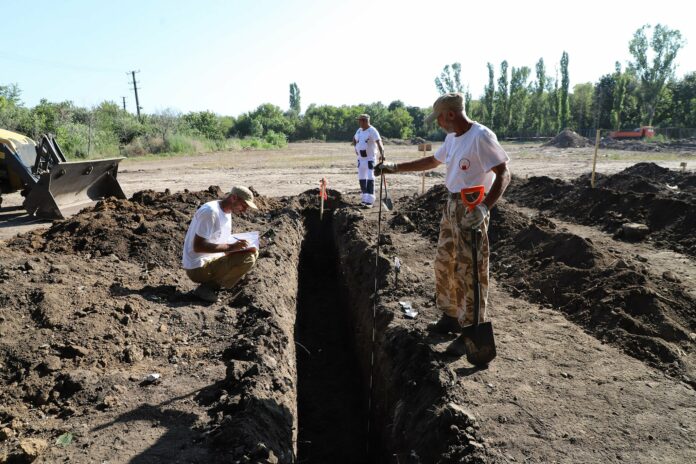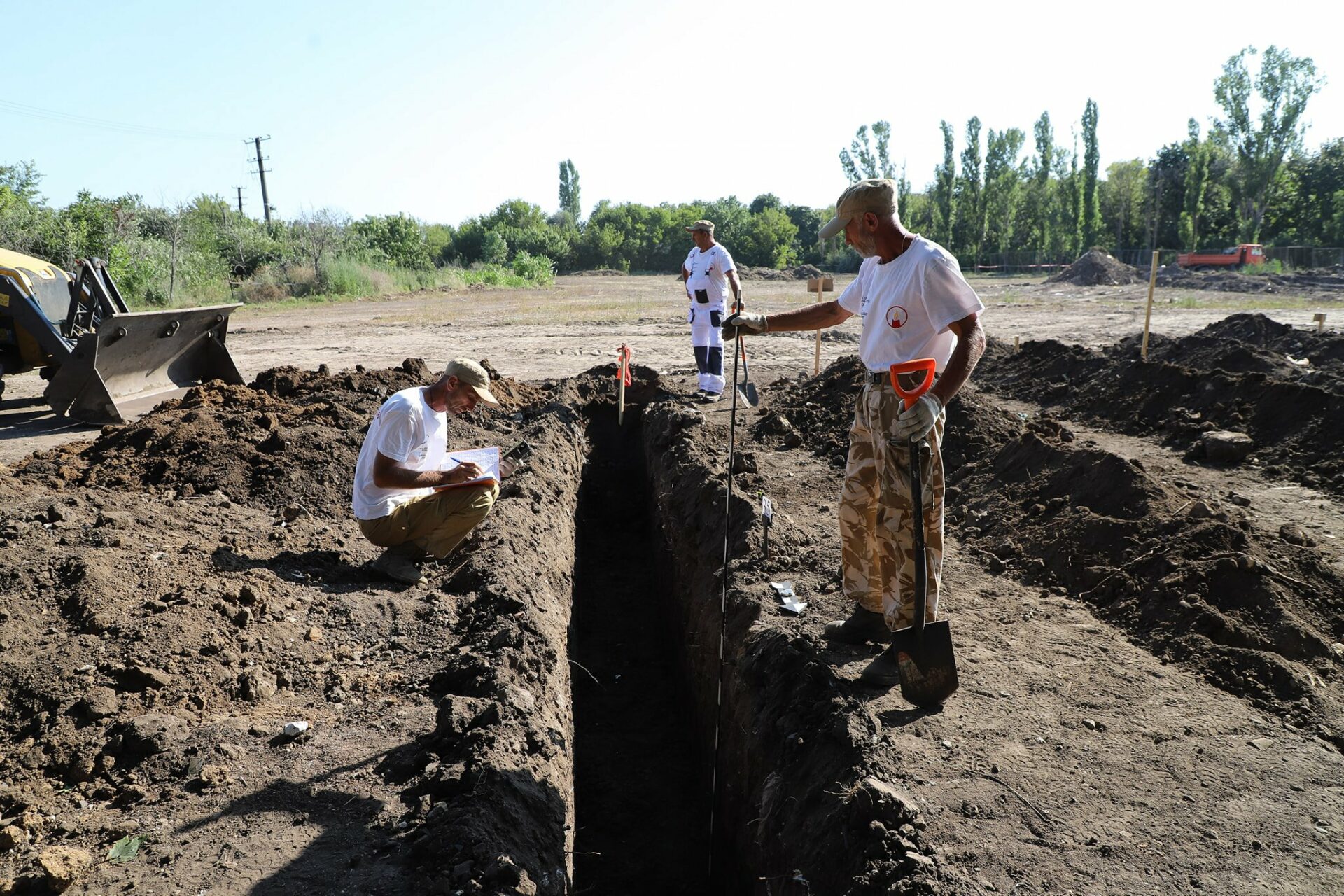While Ukraine mourns the victims of Stalinism, Russia is rehabilitating Stalin. On August 30, mass graves containing the remains of victims of the Great Stalinist Terror were revealed to the journalists in an empty lot near Odessa. Several thousand people had been shot there in the late 1930s. According to experts, this is one of the largest execution sites in Ukraine: the victims were shot without trial and their bodies were simply buried under construction waste. Interview with historian Serhii Hutsalyuk, director of the Odessa branch of the Institute of National Memory, and a member of the inter-ministerial working group on perpetuation of the memory of the victims of war and political repression at the Odessa City Council.
Interview by Natalia Kanevsky.
What are the first results of your research?
On August 30, the inter-ministerial working group published its first conclusions. The excavations were preceded by work in archives and historical research. We were able to establish a list of approximately 40,000 victims of political repression in this region at the end of the 1930s, of whom 8,120 had been sentenced to death. The main site where the condemned were shot is in the suburbs of Odessa, at the 6th kilometer on the Ovidiopolskaya road.
Under what circumstances were these mass graves found?
The documents in our archives (the National Archives of Ukraine, ed.) mention the secret site of the NKVD (Soviet secret service that conducted the policy of terror on the orders of Stalin, ed.) called Tatarka. It is stated that executions took place there.
In 1943, the Romanian occupation authorities carried out the first exhumation on the spot. Thus, the official information about the existence of this site dates from 1943. The Romanian authorities exhumed about 500 bodies. Some of the documents concerning these exhumations are in the Romanian archives.
Requests for documents were sent to the Romanian archives, the German archives, and also to the Russian archives. Since Russia is leading the war against Ukraine, there is little hope that they will respond to this request.
After the liberation of Odessa, did the Soviet authorities conduct an investigation?
In the post-war Soviet era this subject was a total taboo. Near the site is the Odessa airport. In the 1960s, work was done to widen the airport. The workers assigned to this work testified that they found human bones there, including skulls with bullet holes. The KGB agents took charge of the case and the bones were quickly buried to erase all traces. Archive documents are available, including direct testimony from witnesses of this work and airport employees in the 1960s.
So it was necessary to wait for the independence of Ukraine to dig?
In 2008, the site was searched and the remains of 1084 people were exhumed. A few years later, they were finally buried, with a religious ceremony, in the western cemetery of the city of Odessa. A memorial was installed there.
And today?
Last year the City Council applied to the Ministry of Culture for permission to carry out the work on the site. Because the Odessa city airport is expanding, and it needs adjoining land. When this plan was made public, it created great concern in society. Therefore, the state granted permission for this work. The goal is to define the dimensions of this former secret NKVD site, Tatarka and find additional mass graves without exhuming the bodies, as well as to collect artifacts indicating the time of burial, and possibly the identity of those killed.
This bureaucratic process took time, although the city tried to speed it up. Our task force was created to conduct the archival research on the one hand, and to oversee the tracing work on the other. The group is headed by the deputy mayor of Odessa Oleh Bryndak, who is also a historian and a former SBU officer. The group includes officials from the Odessa City Hall, representatives of NGOs such as the German and Polish cultural societies, the Romanian and Polish Consuls, and myself as a representative of the Institute of National Memory.
So, the search began more than a month ago, and to date 29 graves of those shot have been discovered. We will continue this work for another month, as long as the weather permits.
So you are not going to touch the bones?
Exactly. My role in the working group is to oversee that no exhumation is done at this stage of the work. Exhumation must be done with special authorization, and by specialized organizations. This is a crucial thing, because if now, without following this protocol, the exhumation is made in one of the graves, later on there will be no proof of the origin of the exhumed remains.
At the moment, the archaeologists are carrying out their part of the mission on the site. In my opinion, we will finish the reconnaissance towards the end of September – beginning of October, and we will present a detailed report. It should be emphasized that the archaeologists are doing this work on a voluntary basis. They are professionals from our city, but also from Dnipro and Kryvyi Ryh, who specialize in the search for the remains of World War II soldiers. This is the first time in their professional career that they are faced with mass graves of such a size.
What have you found so far?
As was presented to the public on August 30, the archaeologists have found many objects that confirm the period of mass executions. They found coins from the 1930s, rifle and pistol casings from that period, fragments of shoes with 1930s markings, and toothbrushes. In fact, a toothbrush with a bone handle, very well preserved, was cut like a knife. This is a typical artifact of the prison environment. Many perfume bottles were also found. According to specialists in this field, the executioners used perfume and alcohol to remove traces of blood on them. This territory where these twenty-nine mass graves were discovered extends to a military base. The territory of this base must also be explored.
Were you able to establish the number of victims in these graves?
According to the archive documents concerning the death sentences from 1937 to 1939 in this region, it is estimated that there are between five and eight thousand bodies at this site. However, we do not have the lists of those sentenced to death. All these lists are in Russia.
Didn’t the Republican KGB of Soviet Ukraine keep these lists in its archives?
It is estimated that all these lists were transferred to Moscow. Either directly after the fact, or during evacuations of documents in 1941, following the nazi occupation. The experts of our working group who are responsible for the research in the archives have only the verdicts of the “troika” – the extrajudicial judgments against those who were recognized as “enemies” of the regime.
What is the next step in your mission?
As announced by the deputy mayor of Odessa at the press conference on August 30, upon completion of the reconnaissance work, the city will apply to the Ministry of Culture for permission to exhume. The exhumation process will be documented according to existing rules. Burial with a ceremony is expected to follow, with the installation of a memorial at the site that will honor the victims. The religious ceremony should include representatives of all faiths, because, as evidenced by the documents available, there were people of all ethnicities and religions living at that time in Odessa – mostly Ukrainians, but also Germans, Russians, Moldovans, Bulgarians, Jews.
What is the discourse on this vast project of national memory in Ukraine?
This topic is very important for Ukraine, because our country, in the 1930s and 1940s, experienced extrajudicial mass executions in several regions. And in the south of Ukraine, especially in large cities, there are other such sites. In Odessa, the circumstances gave us the opportunity to explore one of these sites, and to demonstrate to Ukraine, and to the whole world, the horror of Stalinist repressions that resemble Nazi crimes. The law in Ukraine condemns both totalitarian regimes: the Stalinist and the Nazi. All countries that were under the control of the Soviet Union, applied these horrifying practices.
I fought for three years in the Donbass and I saw terrifying things there. Yet when I go to this excavation site, it gives me a feeling of pure horror. It is really hard. Personally, I don’t recommend people to go there. It’s a scary place, almost mystical. That is why it is so important to tell the world about it.
Sergei Lavrov recently said that those who attack Stalin are attacking the Soviet victory in the Second World War…
Indeed, our work is of great importance in the present context, where the Russian Federation is actively leading the process of whitewashing the Stalinist regime. They call Stalin “a successful manager”. Their propaganda system and influence work in the former Soviet republics is powerful, and we are not yet able to resist them, we are just learning to do so. Not only in Ukraine, but in Europe in general. It is an experienced and cunning opponent.
Putin recently said that the Ukrainians do not exist as such. According to him, our people are part of the Russian people. Moscow allocates huge budgets for propaganda films and series, and finances subversive activities among our people. It is no secret that a large part of our parliamentarians serve the interests of Moscow. These political forces are also present here in Odessa. And their representatives say: “These people were shot, yes, but they were the enemies of the people”.
What do you expect from Russia, and have you had any feedback from Moscow about these mass graves?
The Ministry of Foreign Affairs has not communicated anything to us. My personal opinion is that Russia is going to put all the documents relating to this matter under wraps, if it has not already done so. There will probably be no response to our request.
Born in Sevastopol, she built her career in Israel and France as a journalist and translator. Since 2013, she has been based in France and served as the correspondent for Radio Free Europe / Radio Liberty in Paris. She is currently the correspondent in France for the public radio of Israel and also works as a sworn translator and interpreter at the Court of Appeal in Amiens.




